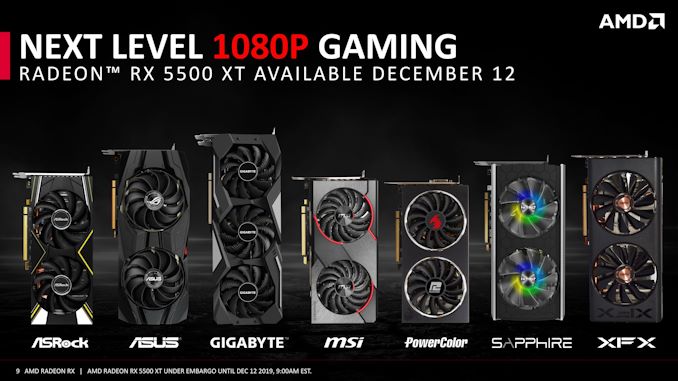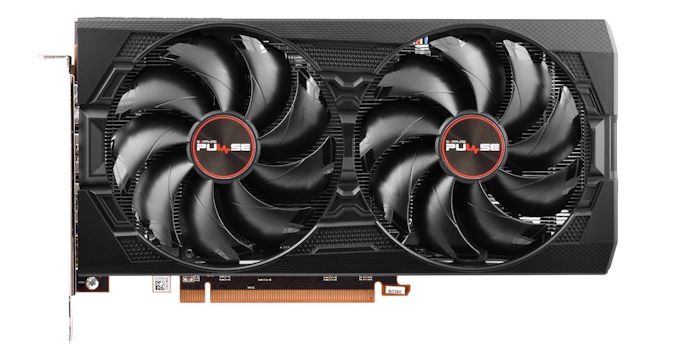The AMD Radeon RX 5500 XT Review, Feat. Sapphire Pulse: Navi For 1080p
by Ryan Smith on December 12, 2019 9:00 AM ESTClosing Thoughts
While the launch of the Radeon RX 5700 series and the underlying Navi 10 GPU was not a slam dunk for AMD’s GPU division, it was none the less an important achievement. The combination of the new RDNA core architecture as well as TSMC’s 7nm process gave AMD a significant kick in both performance efficiency and power efficiency. And in the process, it set a template for all the Radeon RX 5000 series cards to follow.
So it shouldn’t be too surprising then that the new Radeon RX 5500 XT gets to enjoy much the same situation. Compared to AMD’s previous generation Polaris-based RX 500 series cards, the 1080p-focused RX 5500 XT delivers better performance, and it does so while drawing noticeably less power. Even compared to their NVIDIA rivals, AMD is generally competitive on power efficiency in a class of cards where they were well behind in the previous generation.
Competitive performance, meanwhile, is a bit of a trickier subject. As the replacements to the RX 570/580/590 within AMD’s stack, the RX 5500 XT almost always beats AMD’s older cards, the one odd exception to this being Metro Exodus. As a result, AMD’s cheaper 4GB RX 5500 XT looks especially good here, reaching performance parity with NVIDIA’s recently launched and similarly priced GeForce GTX 1650 Super. As is usually the case, the cards are anything but equal on a game-by-game basis, constantly trading wins and losses, but at the end of the day they’re fighting over the same market with the same performance.
The 8GB RX 5500 XT, on the other hand, faces tougher competition. The extra VRAM helps to boost its performance and its price, putting it in competition with NVIDIA’s somewhat awkwardly placed GTX 1660. The GTX 1660 is an odd man out as the only current-generation GDDR5 card among the contenders, and yet it’s still fast enough to remain several percent ahead of the 8GB RX 5500 XT. To be sure, AMD’s new card puts up a great fight, coming closer to meeting NVIDIA in both performance and power efficiency than any previous AMD card; but at the end of the day it’s not enough to completely close the gap with NVIDIA’s closest competitor. Which is not to say that the RX 5500 XT is entirely outclassed here, but the GTX 1660 leads by just enough that it can’t be entirely ignored.
| Performance Summary (1080p) | ||||
| Relative Performance | Relative Price |
|||
| RX 5500 XT 4GB vs GTX 1650S | 0% | +6% | ||
| RX 5500 XT 8GB vs GTX 1660 | -8% | -5% | ||
| RX 5500 XT 8GB vs RX 580 8GB | +8% | +11% | ||
| RX 5700 vs. RX 5500 XT 8GB | +60% | +60% | ||
Throwing a wrench into all of this however – for both AMD and NVIDIA – is VRAM capacity. VRAM isn’t cheap, and GDDR6 even less so, so both vendors are using VRAM capacity as product differentiators and to upsell their better cards. But as VRAM capacity in the $150-$200 price range has been pretty stagnant for the last couple of years now, I do have some concerns about the long-term implications for the 4GB RX 5500 XT, especially with the next-generation consoles set to launch in a year’s time. With the consoles setting the baseline for most multiplatform games, it’s a reasonable bet that VRAM requirements aren’t going to stay put at 4GB much longer. So while the 4GB RX 5500 XT is a great value now, I suspect it’s going to run out of VRAM well before its compute performance gets to be a bottleneck. And while NVIDIA’s GTX 1660 fares better here with its 6GB of VRAM, 6GB is still not 8GB.
Overall then, the VRAM situation adds an extra wrinkle to any kind of product recommendations, as it’s one more variable that deserves consideration.
At the end of the day, I don’t think any 4GB cards are a great choice right now. For buyers who absolutely cannot afford to spend more than $169, then the 4GB RX 5500 XT or NVIDIA’s GeForce GTX 1650 Super counterpart are both going to be the best choices you can make right now, at least among the current-generation cards. However, spending another $30 to get a better card is going to get you a card with at least 6GB of VRAM and 6% more perforamnce, and that’s going to remain relevant for a lot longer than a 4GB card will in 2020.
Choosing between the 8GB RX 5500 XT and GTX 1660, on the other hand, is a bit harder. AMD has a 2GB VRAM advantage, which is likely to be helpful in the future; but right now they can’t match NVIDIA’s performance or feature advantage. Ultimately I’m not sure there’s a clearly correct answer here – at least, not one that can be backed entirely with hard data. In the meantime however, as the second to market it's up to AMD to make a convincing showing if they want to dislodge NVIDIA's existing GTX 1660.
As for Sapphire’s Pulse RX 5500 XT in particular, it’s hard to envision a better card to show off the Radeon RX 5500 XT. If you can look past the card’s somewhat ridiculous size for its class, the product as a whole is just about everything you could want out of a reference clocked card. The build quality is solid, the included TriXX software is handy, and the acoustics are incredible. It may not be a silent card, but with two giant fans to push plenty of air with ease, it may just as well be.
And with that, AMD is set to wrap up their GPU lineup for 2019. At only 3 Navi cards in, AMD is far from done in fleshing out a complete, top-to-bottom family of video cards. But for now, AMD is able to hit the mainstream and performance segments, which is a good place to stop for a bit and reflect as we go into the holidays.












97 Comments
View All Comments
skizlock - Thursday, December 12, 2019 - link
Should be fine.TheSkullCaveIsADarkPlace - Thursday, December 12, 2019 - link
The 5500XT should be alright. But, you didn't say what you are doing, you just said what you are not doing (no gaming). So, i assume you care only about 2D. In which case you could probably select an even more inexpensive GPU that does 4K/60Hz. But then again, it's you who is calling the shots about the things you want to purchase. I am not daring to further step into the line of fire there... ;-)PixyMisa - Friday, December 13, 2019 - link
I have a 580 driving two 4K monitors for work, and it's great.Ranguvar - Thursday, December 12, 2019 - link
Hey Ryan, thank you for the excellent reviews...July 7th, you posted on the 5700 (XT) review that you had "15 pages of notes" on deeper RDNA details that you'd be posting later.
Is this ever coming to fruition? Holding out hope!
Cheers.
TEAMSWITCHER - Thursday, December 12, 2019 - link
I seriously question your motives in this review... Excluding all 1440p results, but then including the Radeon 5700 (a card priced well above this range) just to ensure that AMD has the top position in all the graphs. And your conclusion page make ZERO reference to the GTX 1660 Super card, which can be had for a very good price - $230. I'm seeing this trend all over .. tilting reviews to benefit AMD. I get it.. everyone loves an underdog... but these GPU's are just dogs.Ryan Smith - Thursday, December 12, 2019 - link
The Radeon 5700 is the next card up in AMD's current-generation stack. It's important to include it to show where the 5500 XT ends, and where the next card picks up.Fataliity - Thursday, December 12, 2019 - link
Ryan - Have you tried AMD's new performance boost on the 5500XT to see how it performs? The resolution scaling when moving screen etc? I imagine the Algo feature was built for this card, considering its release and drivers release were in sync. So I'm just wondering how it helps for a budget card?Thank you!
Ryan Smith - Thursday, December 12, 2019 - link
I've tried it. I don't care for it. But I'll give AMD tons of credit for trying new ideas.But I'll save that for once I can write up something proper.
Zoomer - Saturday, December 21, 2019 - link
Overclocking?Hrel - Thursday, December 12, 2019 - link
Nah, its pretty bs you didn't include 4k results. The ONLY reason to buy the 8gb version is 4k and now I gotta go elsewhere to find out how the gpu uses that extra vram. Very dumb not to include 4k.